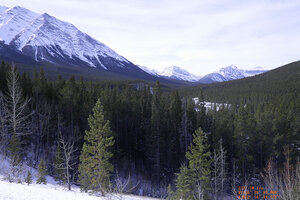A final blow to myth of how people arrived in the Americas
Is there any way the first Americans migrated south along the Pacific coast through an ice-free corridor? No, say scientists.

A present day view of the area where retreating ice sheets created an ice-free corridor through the Canadian Rockies more than 13,000 years ago.
Courtesy of Mikkel Winther Pedersen
For decades, archaeologists thought they knew how the story went: Humans migrated from Siberia to Alaska over the Bering land bridge during the last Ice Age, but were stuck there until a corridor opened up between the eastern and western ice sheets covering much of what is now Canada. Then, the Clovis people – thought to be the first to spread across the Americas – took that new path down to the rest of the continent.
But when fresh evidence poured in suggesting people were in the Americas long before the distinctive Clovis spearpoints showed up, the Clovis-first model was discredited.
And now, scientists say that the Clovis people didn't even arrive via that corridor.
It all comes down to timing, according to new research published Wednesday in the journal Nature. The ice-free corridor through the Canadian cordillera couldn't have supported human migration until about 12,600 years ago. But the Clovis people were already living south of the ice sheets by 13,500 years ago.
So what did happen?
The broad strokes haven't changed. When the Ice Age lowered sea levels and turned the Bering Strait into a land bridge, ancients migrated from Siberia to present-day Alaska, where they encountered a massive icy roadblock preventing further migrations deeper into the Americas. So the people hunkered down in that small Alaska region, called Beringia, for thousands of years.
By about 16,000 years ago, people found their way around the ice sheets, according to archaeological sites across North and South America.
The dominant theory today is that these people came down the Pacific coast either by boat or when the ice sheets retreated enough to reveal a coastal walkway, long before the ice-free corridor had opened up.
Because of evidence of humans living as far south as Chile, well before Clovis culture appears in the archaeological record, the Clovis-first model has long been dead, says David J. Meltzer, a paleoanthropologist and archaeologist at Southern Methodist University.
But the unresolved question that remained was whether Clovis groups descended from the people that made their way down the Pacific coast, "and thus were here already and didn't need a corridor, or whether they represent a separate and later migration and – if so – whether they could have come down the ice free corridor," Dr. Meltzer, who is a co-author on the new Nature paper, tells The Christian Science Monitor in an email.
And, he says, "based on our new results, we answer no to that question."
It's not as simple as figuring out when the ice-free corridor opened up. The corridor is thought to have actually been open around 15,000 to 14,000 years ago – early enough to predate the Clovis settlements south of the ice (although they would have had to hustle to make it from Beringia to those settlements via the corridor).
But just because there wasn't an ice sheet in their way anymore, doesn't mean that people could have migrated down the approximately 930-mile-long corridor. After being scoured down to bedrock by mile-high ice sheets, it took time for the land to become biologically rich enough to support migrating humans.
Plants and animals would have to be thriving along the whole corridor to provide inviting food sources, wood for fire, and other survival needs. Humans venturing out from Beringia likely didn't know what lay to their south, so they wouldn't have prepared for a long journey. They would have simply seen a new region of land to settle.
And, as Meltzer told Nature, "It's 1,500 kilometres. You can't pack a lunch and do it in a day."
So Meltzer and the research team, led by evolutionary geneticists at the University of Copenhagen, set out to see when plants and animals came back to that newly ice-free corridor. They focused on a section of the corridor that was one of the last to become ice-free and dug into lakebed sediments for clues as to what once lived there. The team radiocarbon dated pollen and fossils, and looked at the DNA remaining in the sediments to determine when life came back to the region.
And they found that before 12,600 years ago, vegetation and animal life was too sparse to support a human population.
This new paper isn't the first to suggest the ice-free corridor wouldn't have been biologically viable for humans until after the first appearance of Clovis culture in the archaeological record. A study published in the Proceedings of the National Academy of Sciences in June found that bison populations from north and south of the ice sheets didn't intermingle until about 13,000 years ago.
"Given that their approach is completely independent from that used in our bison study, I find it encouraging that there is only an ~400 year discrepancy between the two estimates," Peter D. Heintzman of the University of California, Santa Cruz, the lead author of the bison study, tells the Monitor in an email.
And "both papers are in agreement" as to the significance of the ice-free corridor for human migration, he says. "They both suggest that the corridor opened too late for it to be the route for initial colonization of the Americas south of the ice."
And that rules out the idea that the Clovis people came down the corridor, Meltzer writes in an email. "I think we both also agree that the first hard [archaeological] evidence in the corridor when it finally opens is post-Clovis in age, and likely from people moving north and not south."

